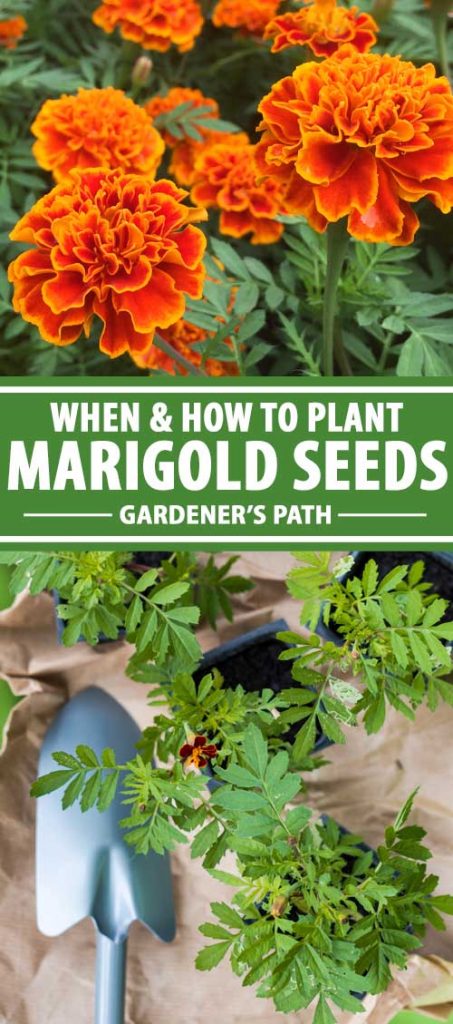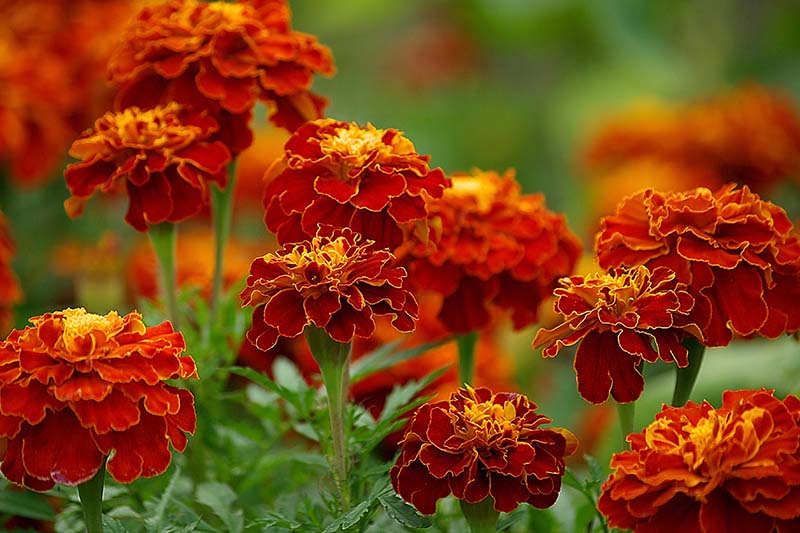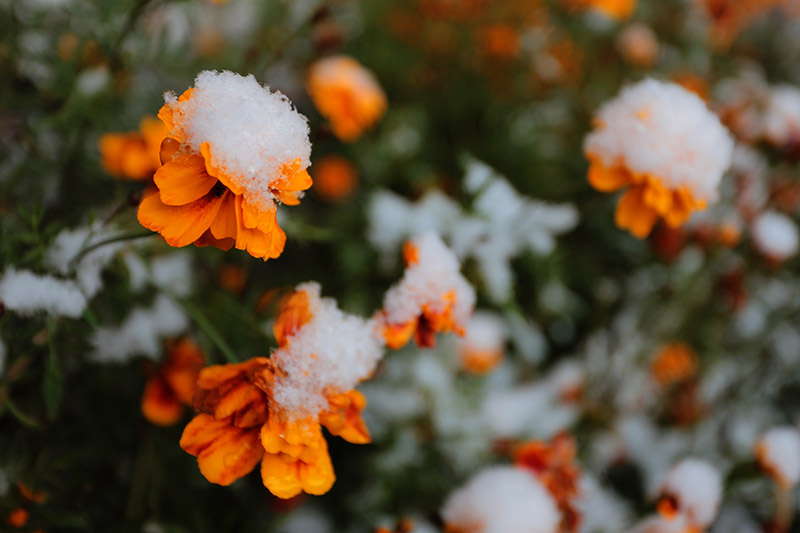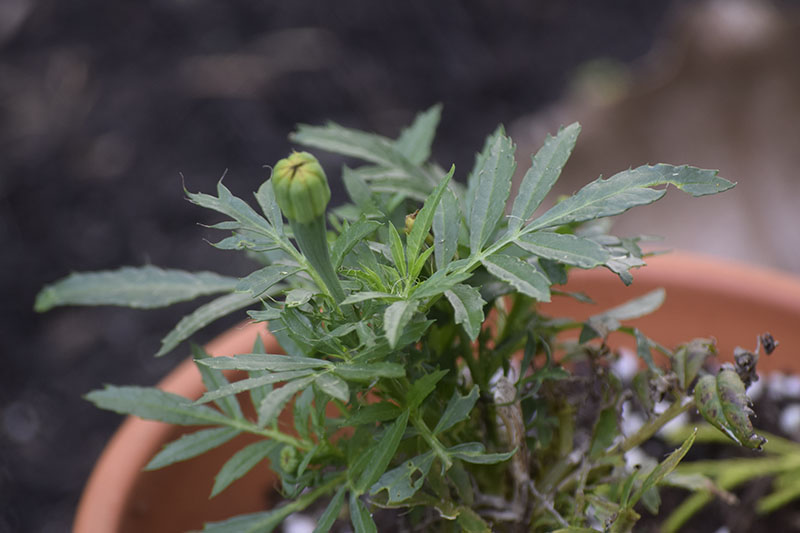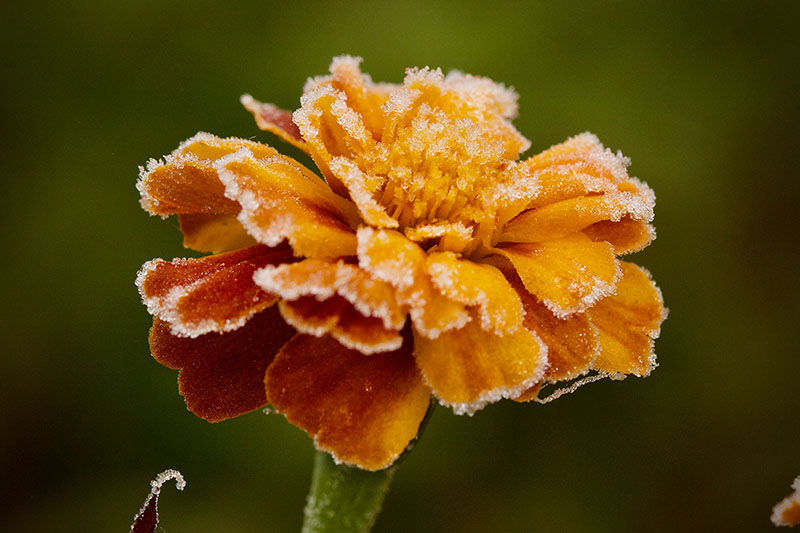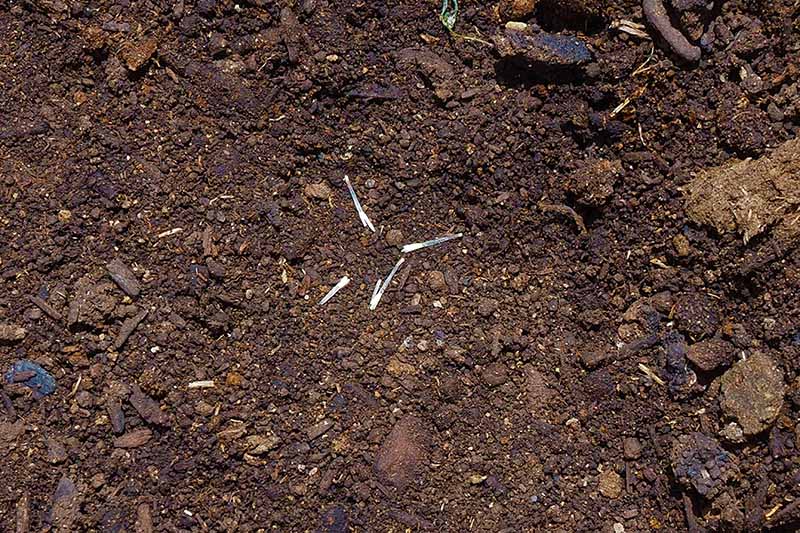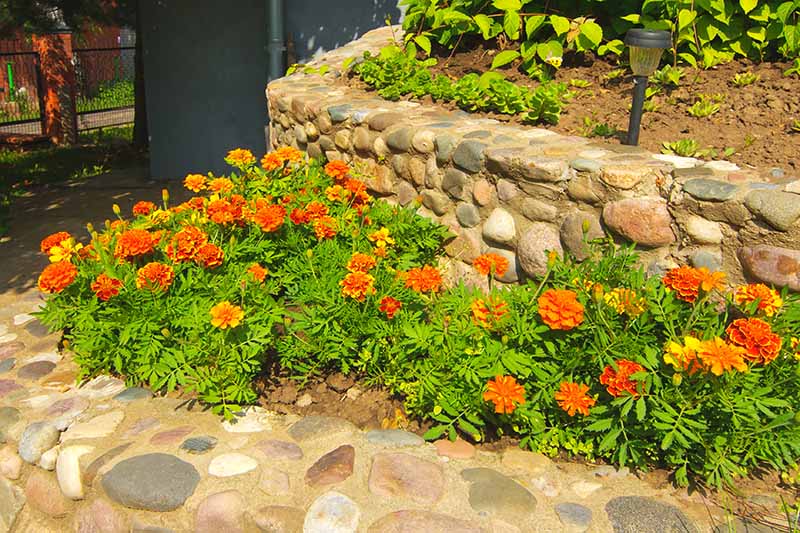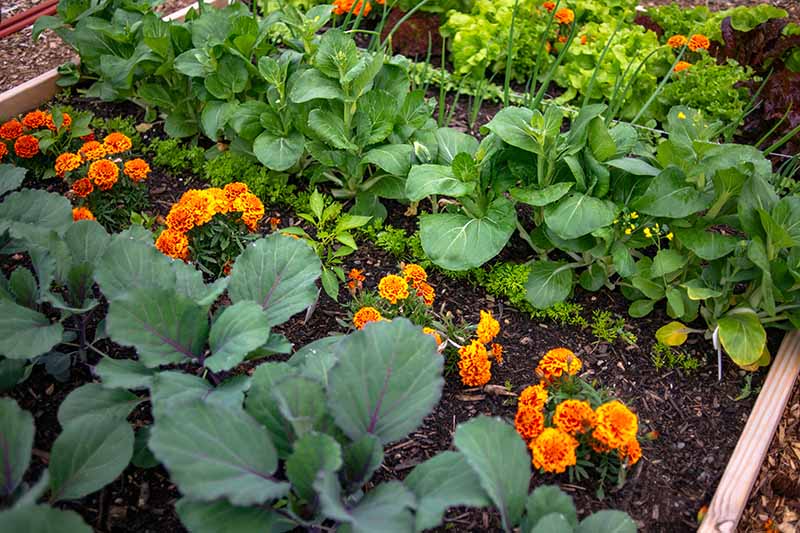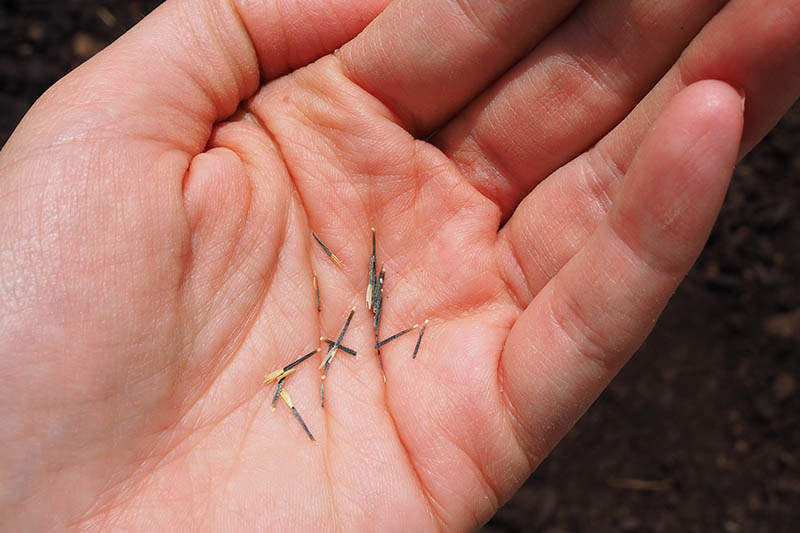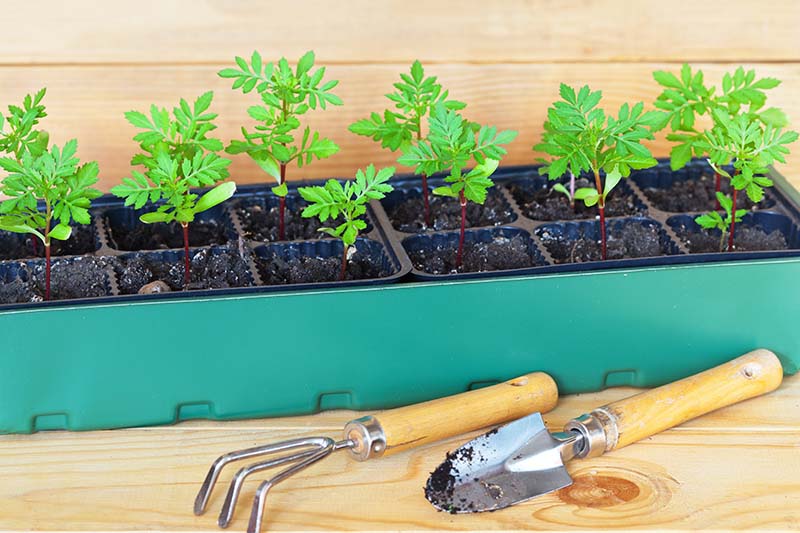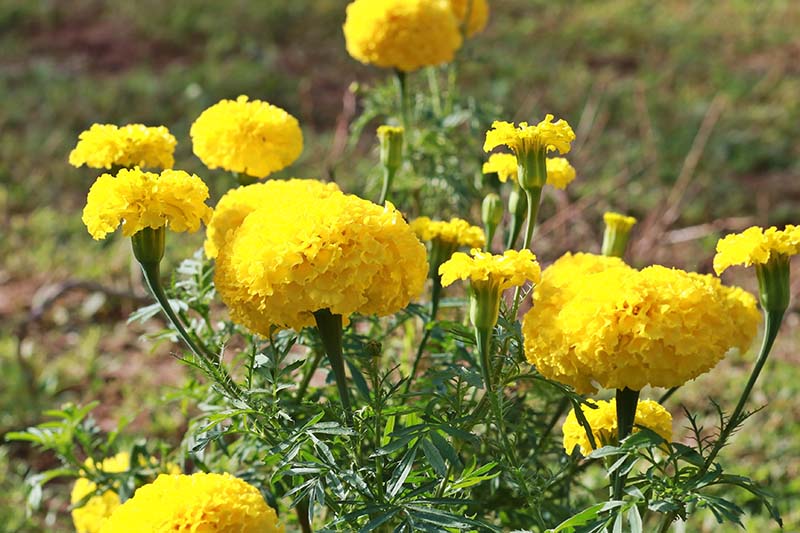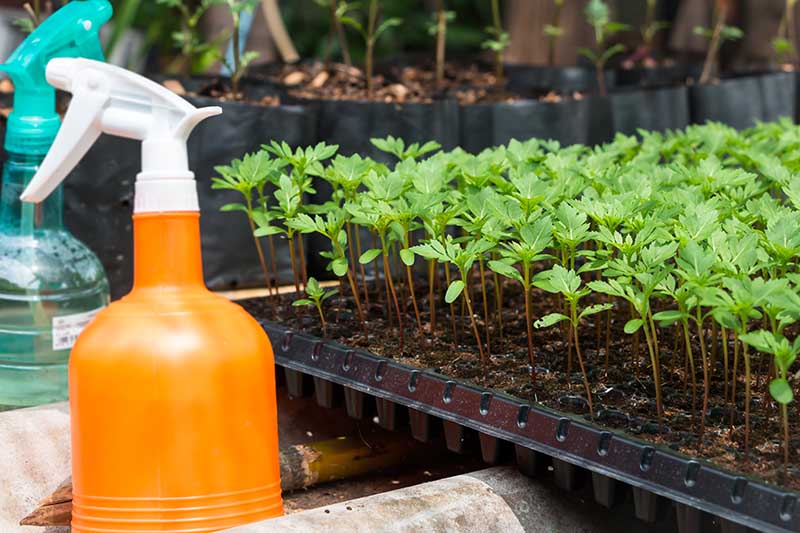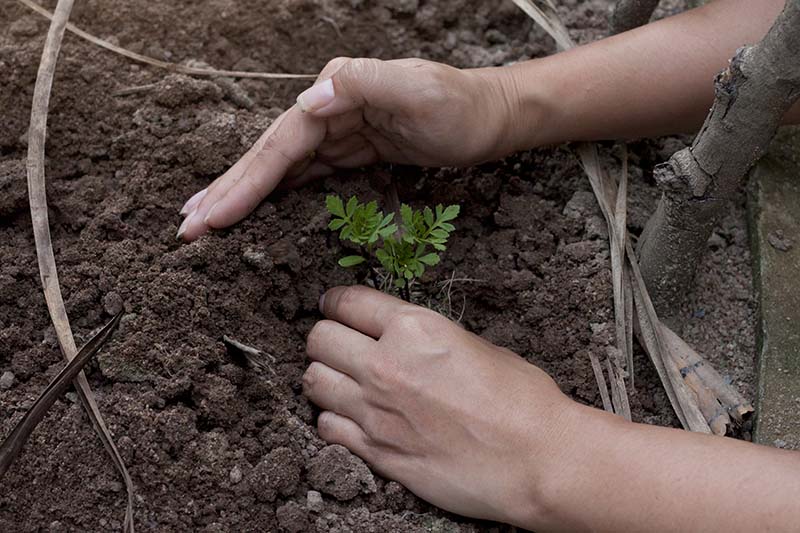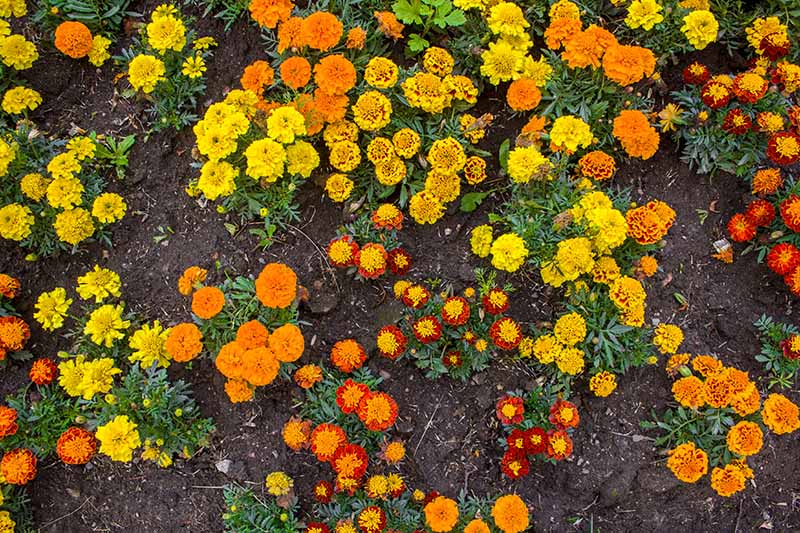And once summer is at full tilt, I love seeing their happy yellow, orange, and red flowers brightening up my garden. If you’re a fan of marigolds too, you probably purchase a flat or two every year to add to your own vegetable garden, or arrange in your flower beds or planters. But once you cross the line from fan to fanatic like I have, you may want to start growing these annuals from seed. We link to vendors to help you find relevant products. If you buy from one of our links, we may earn a commission. Deciding whether to sow your marigolds directly in the garden or start them indoors will require you to take a few factors into consideration: the length of your growing season, the type of cultivar you’re planting, and how impatient you are for these annuals to fill your garden with flowers. I’ll go over each of these different factors, so you can decide which method will work best for you.
The three main species of marigolds found in US gardens are the Mexican (sometimes called African) marigold, Tagetes erecta, the French T. patula, and the signet marigold, T. tenuifolia. Another member of the Asteraceae family, Calendula officinalis is known as the pot or English marigold. In this guide, I’ll go over how to start the three Tagetes species from seed. Here’s what I’ll cover:
Why Sow Outdoors
Sowing seeds outdoors is more straightforward than starting them indoors. There are fewer steps involved, fewer materials required, and you avoid the risk of transplant shock.
If you’d rather forego an indoor seed starting project, there are some cases where you can get away with sowing marigolds directly into your garden:
If you are growing a faster maturing variety, such as most French (T. patula) and signet marigold (T. tenuifolia) cultivars. If you are willing to be patient for flowers to appear. If you have a long growing season.
Let’s talk more about that last point. How do you know if you have a long growing season? If you are able to successfully grow warm-season crops like tomatoes, squash, eggplant, and peppers without concerns about them being killed by early frosts, you probably have a long growing season in your area. On the other hand, if you have had issues with these crops getting hit with early frosts in the past, you are probably like me and many other northern and high elevation gardeners who must deal with the challenges of a short growing season.
Here’s a more precise way to find out if you have time to sow these annuals outdoors: Compare the number of frost-free days in your area with the number of days the plant needs to reach maturity. If you don’t know how many frost-free days you have, you can quickly calculate them with this tool from the National Gardening Association. Just enter your zip code, and it will tell you the average number for your area. Now find the days to maturity for your selected variety or cultivar. This information is usually located on the seed packet. If you can’t find this information on your seed packet, French marigolds (Tagetes patula) will generally bloom in 50-60 days, while Mexican marigolds (T. erecta) need 70-100 days. Signet marigolds (T. tenuifolia) often flower in just 60 days, depending on the variety. Compare your number of frost-free days with the number of days the plant needs to reach maturity. If your marigold takes 100 days or more to bloom, and your growing season has 190 days total, that means you’ll potentially get to enjoy the flowers for about three months. Seems like a good deal to me!
However, if your growing season only has an average of 104 days (my growing season is closer to this number), you might not get to enjoy the blooms at all if you sow seeds outdoors. The most you may get are some buds. So if you have a short growing season, start the slower maturing varieties indoors, and for direct sowing, consider a faster maturing variety. Learn more about when to sow seeds indoors versus outdoors in this guide.
When to Sow Outdoors
Marigolds are tender annuals, which means they are not at all cold hardy and will be damaged or killed by frost. That’s why these plants smell like summer – and not spring.
While mature marigolds may be able to tolerate just a tiny amount of frost, young seedlings are generally more sensitive and it’s better not to risk exposure to the cold. If you decide to sow directly into your garden soil, plan on doing this about a week or two after your last average frost date. That way, once your marigolds germinate, the risk of late frosts will likely already have passed.
How to Sow Outdoors
When you’re ready to sow, first choose a full sun location in your garden. These annual flowers can tolerate some shade, particularly if your summers are really hot. However, flowers will develop more striking colors if they are planted in full sun.
When considering where to plant your marigolds, be aware that these plants need to grow in soil that drains well. If you’re dealing with heavy clay, mix in some compost to help with drainage. Alternatively, sow your seeds in raised beds.
Before sowing, wet the soil lightly with a gentle spray from the hose. I like to do this several hours before I sow my seeds, so the soil is moist but not soggy at planting time. Scrape back a little bit of soil to use for covering the seeds. Level out the soil and pat it gently to firm it up. Pour some seeds into the palm of your dry hand so that you don’t accidentally end up dumping the entire contents of your packet onto the soil all in one spot. These seeds are light and airy, and that can be easy to do! Place groups of 3 or 4 seeds on the prepared soil, spaced 6-12 inches apart, depending on the mature spread of your chosen variety. You’ll need to leave more room between each plant if you are growing larger varieties. In general, you can plant smaller cultivars 6-8 inches apart, and larger ones 10-12 inches apart. Press seeds lightly into the soil, then cover lightly with the soil you pushed to the side, so that they are buried 1/2 inch deep. Pat and smooth the soil gently, and water lightly with a watering can, or using the gentle shower setting on your watering wand. Make sure to water every day until seedlings emerge. Gradually taper off watering so that established plants receive about 1 inch a week.
Why Start Indoors
Do you think sowing seeds directly in the garden might not be the best option for you? Here are some reasons why you might want to start your marigolds indoors instead:
If you have a short growing season. If you want blooms early in the summer. If your area is prone to late killing frosts in the spring or early summer. If you are growing a slower maturing variety, such as most T. erecta cultivars.
When to Start Indoors
If you decide to start your seeds indoors, plan to sow them 6-8 weeks before your average last frost date. Allowing your marigolds 6-8 weeks of growth before setting them out will give them a jump start, and you’ll enjoy the blooms earlier than if you were to sow them directly in the garden.
They will be ready to transplant into your garden at the beginning of your local warm season, and the earlier maturing varieties will bloom soon after transplanting them.
How to Start Indoors
Starting marigold seeds indoors is pretty easy, but it does require a few materials and supplies. If you’ve never started your own annuals from seed, you might want to review our complete guide to starting annuals from seed indoors.
Here are a few tips for you to get started:
Use sterilized potting soil or soilless starting mix. Plant 2-3 seeds per starter tray cell. When seedlings are about 2 inches tall, thin out all but the strongest plant from each cell. Water daily with a spray bottle to prevent water logging and alleviate the risk of damping off. If using the light from a south-facing window instead of grow lights, turn your trays daily to help straighten out seedlings, which will tend to lean toward the light.
About a week before you wish to transplant your seedlings, start hardening them off outdoors to acclimate them to their new growing conditions. First, place them outside in a shaded location where they are protected from wind.
Over the course of a week, gradually increase their exposure to direct sun and wind by about an hour a day, until they outdoors for the entire day, placed in the location where you intend to plant. Plant your transplants in a full sun location with well-draining soil, and water them in. I like to do my transplanting on a cloudy day or in the evening, so the transplants don’t have so much heat stress to deal with while they acclimate themselves. This also helps to protect me from the sun too!
Water daily for the first week. Once plants are established, give them a good soak about once a week. Water only at the ground level, and avoid spraying the flowers directly with water to keep your blooms looking fresh instead of soggy and wilted.
Recommended Cultivars
I honestly haven’t met a marigold I didn’t like, but there are some cultivars I’m particularly excited about, and I’d like to share these with you. All of these recommendations are the faster-maturing French type marigolds, T. patula. You’ll enjoy gorgeous blooms early in the season, whether you sow indoors in flats or outdoors in the garden.
Queen Sophia
‘Queen Sophia’ is an All-America Selections Winner whose fiery petals are warm and entrancing. The petals of this French type are dark orange with yellow edges, and its double blooms measure 2 to 3 inches across.
‘Queen Sophia’ Plants grow 10-12 inches tall with a spread of about 8 inches. ‘Queen Sophia’ will reach maturity in 60 days. You’ll find ‘Queen Sophia’ seeds in a selection of package sizes at Eden Brothers.
Strawberry Blonde
Marigolds are typically limited to shades of yellow, red, and orange – so spotting a unique, pink-colored cultivar such as ‘Strawberry Blonde’ is quite a thrill. The flowers of this variety start out red, and then transform into a lovely pinkish-yellow hue.
‘Strawberry Blonde’ Plants reach 8-10 inches tall and have a 6 to 8-inch spread at maturity. ‘Strawberry Blonde’ will reach maturity in 55-70 days. You’ll find ‘Strawberry Blonde’ in packs of 50 seeds for purchase exclusively at Burpee.
Durango
When you just can’t decide which type of marigold to grow, why not go for a mix? The ‘Durango’ mix comes in a beautiful mélange of solid yellow, orange, and burgundy hues as well as some enticing bicolor patterns, with double blooms reaching 2 to 2 1/2 inches across.
‘Durango’ Mix Plants reach 10-12 inches in height and have a 9-inch spread. Flowers in the ‘Durango’ mix come to maturity in 50-60 days. You’ll find the ‘Durango’ mix, and an assortment of other ‘Durango’ colors, in packs of 1000 seeds at True Leaf Market. If you want to harvest and save your own seeds for use the following year, you’ll want to choose old-fashioned heirloom cultivars rather than newer hybrid types. These lovely flowers come in a huge range of red, yellow, and orange color pallets, shapes, and heights. Find the perfect variety for your home and garden with our guide, “31 of the Best Types of Marigolds.”
Turn Seed into ‘Golds
Considering all the factors – the length of your growing season, your chosen varieties, and how quickly you want to enjoy the blooms – you should have a pretty good idea by now of the best way to turn seed into ‘golds.
So, what have you decided, gardener? Will you be sowing outdoors or starting indoors? Or perhaps both? And which wonderful varieties are you growing? Let us know in the comments below. And to learn more about growing marigolds in your garden, why not check out the following guides next:
How to Use Marigolds for Pest Control Tips for Deadheading Marigolds 17 of the Best Marigold Companions How to Grow Marigolds in Containers
Photos by Kristina Hicks-Hamblin © Ask the Experts, LLC. ALL RIGHTS RESERVED. See our TOS for more details. Product photos via Burpee, Eden Brothers, and True Leaf Market. Uncredited photos: Shutterstock.
